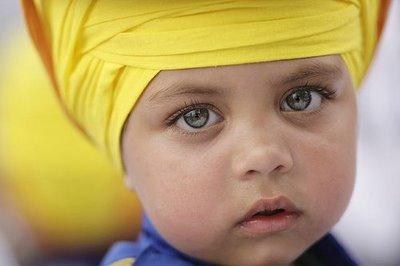VAISAKHI OF THE SIKHS:
Remembrance, Preservation, Celebration, Restoration & Continuation
I.J. Singh
 All 25 million Sikhs around the world remember Vaisakhi
1699, the historic day that Guru Gobind Rai appeared at a massive conclave of
the Sikhs at Anandpur Sahib, flashed a naked sword and demanded a head.
All 25 million Sikhs around the world remember Vaisakhi
1699, the historic day that Guru Gobind Rai appeared at a massive conclave of
the Sikhs at Anandpur Sahib, flashed a naked sword and demanded a head.
History tells us that after much trepidation one Sikh, Dya Ram, offered his head. The call was repeated until five volunteers materialized. The Guru then initiated the five into the new order of the Khalsa.
Then, at his request, the five initiated the Guru who became Guru Gobind Singh.
This, we believe, was the final step in the evolution of the Sikh movement started by Guru Nanak two centuries earlier in which the Sikh lifestyle and world view become clearly and fully delineated with an independent identity.
One can elaborate on this very skimpy outline and a slew of scholars and critics have weighed in on it over the past three hundred years. I am sure many more will continue to do so until the end of time.
But I come at it today from a radically different direction.
When we talk of Vaisakhi, as we do every year, we recognize the finality of the message in 1699 and hardly note any changes in our structural framework, mission or message due to the passage of time.
We treasure Vaisakhi 1699 as the year of the birth of the Khalsa but hardly note that every child’s birth depends on a year or so of preparation before a newborn is delivered to the world.
We remember the birthday and its date but fail to take into account that the newborn is now over 300 years old.
Obviously the birth of the Khalsa in 1699 was made possible, even necessary, by the prior 200 years of growth in the Sikh movement and its identity was made possible by the personal mentorship of the nine Gurus, from Guru Nanak to Guru Tegh Bahadur, that preceded Guru Gobind Singh, as well as the Sikh institutions and worldview that evolved during those two centuries of the Guru period.
I have taken more detailed stock of these matters in an earlier 2012 essay titled “Vaisakhi Redux” and so will sidestep these matters today. Let me come from a tangent instead to the post 1699 period today.
What brought this home to me was a recent panel on the tube. I was listening to some talking heads on television passionately dissecting the meaning, purpose and mechanics of the American Revolution. These events date from the 1770’s. To some the Founding Fathers were no less than prophets who had been touched by God and set on a divine mission. Hence the society founded by them was no less than a holy Church and we could do no better than to preserve the structure that has been bequeathed to us. One does not mess with perfection.
Others had a more Earthly take on the perfection and the pristine purity of the nation’s Fathers, their message, motives and their mission.
The words that continue to haunt me are those of Chris Mathews, an iconoclastic liberal political Pundit, who is rational but not always reasonable. He said, “The (American) Revolution started well over two centuries ago but it continues today. It did not end then and it hasn’t ended now.”
Of course, he and others like him rest their case on how the nation’s reality has changed from its inception on matters like slavery, racial and gender equality; the ideas of what it means in matters like equal opportunity when we speak of life, liberty and the pursuit of happiness. These are, of course, not easy matters; just look at issues like immigration reform, universal health care, and gender issues that continue to rile up the nation even today.
 There are those who look at the societal reality during revolutionary
days and forcefully want to reject any modern expansive interpretation of the
words of that time. They forget that
words reflect the context and meaning of the time and societal values extant
then. Life does not stop; it is not fixed forever in anything – not in the way
we live, eat, travel or relate to the rest of the world. And words themselves mutate and change their meaning
and application. Language too evolves as our lives change. That is how I look at the inevitability of
all the amendments to the Constitutions of nations, including this one, that
have resulted over the years and will continue to arise as needed. The idea is to evolve into a more fruitful,
more egalitarian and more just society with more transparency, accountability,
integrity and self-governance at the core.
There are those who look at the societal reality during revolutionary
days and forcefully want to reject any modern expansive interpretation of the
words of that time. They forget that
words reflect the context and meaning of the time and societal values extant
then. Life does not stop; it is not fixed forever in anything – not in the way
we live, eat, travel or relate to the rest of the world. And words themselves mutate and change their meaning
and application. Language too evolves as our lives change. That is how I look at the inevitability of
all the amendments to the Constitutions of nations, including this one, that
have resulted over the years and will continue to arise as needed. The idea is to evolve into a more fruitful,
more egalitarian and more just society with more transparency, accountability,
integrity and self-governance at the core.
Yet there remain excellent minds that seem frozen in time. I point to some scholars and legal luminaries like Justice Antonin Scalia of the Supreme Court who has a razor sharp intellect. He and many like him appear to be totally wedded to the idea that in interpreting the laws of the country we must remain faithful to the original intent of the founding fathers of the nation; any re-interpretations of their words that take into account the intervening two centuries and the transformation of society must be rejected.
It seems to me that such a self-limiting view must by nature become a prison that holds us back in time and limits us. A lively debate, of course, continues. Witness the hot and heavy disagreement that focuses on the meaning of the Second Amendment even today.
For parallels of such thinking explore any religious tradition where newer interpretations and analyses are discouraged because such intellectual processes would “diminish” the sacred nature of doctrine and tradition. I can supply such examples from secular non-religious literature as well, more from the liberal arts and less from science.
I suppose such is human nature. Interpretation, analyses and change appear threatening, like the ground shifting underfoot. In stability and unchanging realities there lies comfort. But then these matters need to be balanced – for without change there is no progress and no life.
When matters come to religions we unquestionably take a few more regressive steps back. To us the message, its interpretation and meaning is etched in stone, and any change is blasphemy, pure and simple.
We forget that religions, no matter how old or new, were often radically revolutionary when they came to be. That’s why their founders often suffered at the hands of the powers to be, and even from lesser despots. Religions and their founders often challenged the existing order. And we treasure the message just because they give us a way of life and define a social order – a community, or even a nation. Nations need borders much as neighbors need fences, to define “us” and “them” and “ours” and “theirs” so as to reduce conflict between them, but never to seal one off from the other.
These borders help us to protect and preserve. The idea is not so much to worship but to live the life style that a religion asks us to do – for that is the best worship of all. Again, as in civic society, the social fabric – religious or secular – must operate with transparency, honesty, accountability and self-governance at its core. To me that's the primary purpose of a religion – to define a way of life and a framework of social mores and ethics, and not so much to worry or obsess about a life hereafter. To neglect the here and now for a fanciful and imaginative tomorrow is not the purpose at all — certainly not at all in Sikhi.
It seems to me that each new generation must reinterpret, re-explore, re-examine and rediscover the way of life, not merely follow it slavishly, but rather internalize it — so it is alive and real. Every year the message of Vaisakhi must start with the 200 years that preceded 1699 and it must continue to explore the 300 years that followed it and then take us forward to what will be – our hopes and dreams of tomorrow here on Earth.
The point is that the significance of Vaisakhi did not start with 1699 nor did it end on that day. The revolution of Vaisakhi continues apace and is, in fact, undiminished today. We need to move our heads, hearts and beings into the 21st century to see it. That, if anything, will make our religion alive, relevant and thus sacred.
Hail Vaisakhi 2013!
Note: This essay is based in part on the essay “Vaisakhi
Redux” from the book “SIKHS TODAY:
Ideas & Opinions,” 2012 by I.J.
Singh. Ethnic Island, California






